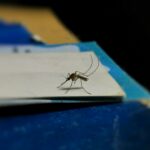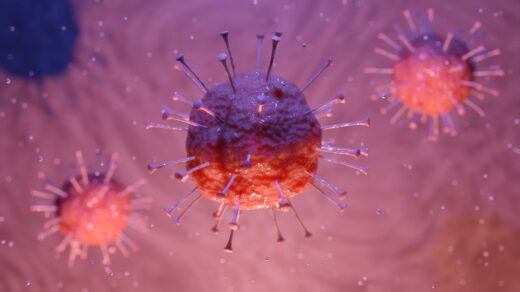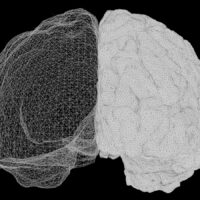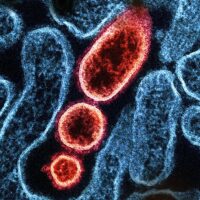The Era of Enormous Insects in the Carboniferous
Imagine a huge spider falling from the ceiling on your head or better don’t imagine it unless you are among the tiny percentages of people who are not afraid of spiders. You for sure won’t be back for more. This can hardly be compared to anything else. Even if you know for sure that this particular spider isn’t poisonous and is completely harmless, the average person doesn’t need to even touch the spider to be scared to hell. For many people it’s enough just to see the bug. At that moment they instantly wish to be somewhere on another planet, as far away as possible. The bigger it is, the scarier it is for us. And the list of our phobias isn’t just limited to spiders. Scolopendra, scorpions, cockroaches, and so on, they put fear and horror in us.
But today’s bugs are well just microscopic animals compared to the monsters that dominated our planet millions of years ago. And if you still want to rattle your nerves, you’ve come to the right place. In this video, you’ll learn how insects appeared, what made prehistoric insects so huge, how the gigantism of prehistoric bugs, oxygen, and coal are related, whether insect giants might reappear on Earth, and finally, the Carboniferous period and the rise of the giant bugs.
We’ve been used to the fact of their existence since childhood. We take them for granted without thinking about how little we know about these creatures. For example, did you know that some estimates put the weight of all insects on the planet at about 1 billion metric tons? According to researchers at Israel’s Weizmann Institute of Science, that is about as much as the weight of all the humans (about 400 million tons) and all farm animals (about 600 million tons) combined. It’s also more than 3,000 Empire State Buildings. To make it even more convincing, Mount Everest weighs about 1.2 billion tons—that’s only a little more than all the insects combined.
But there are more interesting things than statistics. For example, this paradoxical combination: for many insects, such as grasshoppers, hearing is crucial. Both their survival and reproduction depend on it. But grasshoppers aren’t equipped with any ears. Instead, they’ve learned to hear with their knees and abdomen. Membranes work there on the same principle as our eardrums.
Or, for example, do you think gears are purely a human invention? Are you sure that nature can’t create something like that? You underestimate nature and evolution. Take a look at this: it looks very much like some sort of artificial mechanism, but it’s actually the structure of the leg of a Saka from the Issus family, Issus coleoptratus. It’s a creature with very powerful limbs that allow it to develop a jump speed of 4 meters (13 feet) per second from the start. Furthermore, the direction of the jump and the place of the landing are extremely precise. This speed and, most importantly, precision is possible thanks to the special knee joint, which resembles a gear train. Ordinary nerve impulses would not allow the insect to synchronize the movements of its limbs when pushing from the surface, but those gears can do it.
In general, we think of insects mostly as pests, and for good reason. Insect pests eat up a quarter of the world’s crops every year. But at the same time, there are bees. An average bee swarm produces about 150 kg of honey in a hive for the winter. Thus, one bee produces less than 1/10th of a teaspoon of this product during its entire life. And bees are the most obvious example of the usefulness of some insects. There are also silkworms, which provide us with a fiber of unique qualities. In general, insects prove to be extremely important to humans, even in the most unexpected industries.
For example, you’ve certainly dealt many times in your life with a substance called carmine. It’s a bright red dye and is registered as food additive E120. It’s been used since ancient times to dye fabrics and yarn. Nowadays, carmine is used in the cosmetic industry, including the production of lipsticks, eyeshadows, and blushes. And this is only a small part of it. It’s even widely used in the food industry to color candies, gum, juices, yogurts, and many other things. Now get ready: this dye is made of this. It’s cochineal, a collective name for several species of insects of the Hemiptera order. The female larvae of these creatures are used to produce this red substance. It takes about 70,000 larvae to produce 1 kg of carmine. So if you believe you’ve never and will never eat insects, we have bad news for you.
Yes, insects can be both helpful and extremely destructive. The good news is, at least they’re small. But that wasn’t always the case. There was a period in Earth’s history when many bugs reached sizes unbelievable for us by today’s standards. These monsters were at their peak about 300 million years ago in the late Carboniferous period. It was then that 2 or even 3-meter-long millipedes crawled in the dense vegetation of the Carboniferous forests. Scorpions the size of dogs ran around, and giant dragonflies the size of the largest modern seagull (up to a meter in wingspan) flew one floor up.
But why exactly in this period?
And why is it the opposite now?
To answer these questions, let’s look at what our planet was like back then. To say it was different is an understatement.
Let’s go back by 420 million years for a better understanding. We’ll look a little earlier at the Devonian period, which preceded the Carboniferous. The Devonian was the fourth and one of the longest periods of the Paleozoic Era, lasting from about 420 to 360 million years ago. Back then, Earth looked more like some Earth-like exoplanet from the Kepler Observatory’s recent discoveries. Even if you were lucky enough to see the Earth of that time from space, you wouldn’t recognize it. Here’s a rough map of the continents at the time:
It’s difficult to distinguish any recognizable shapes. The global climate during the Devonian period was very mild, with average temperatures ranging from 25 to 30°C (77 to 86°F). The North and South Poles were only slightly cooler than areas closer to the equator, and there were no ice caps. The only glaciers, if any, were on the high mountain ranges. The small continents of Lonia and Baltica joined together to form Euramerica, also known as Laurussia. At the same time, the giant Gondwana continued to drift slowly southward. The huge supercontinent then included Africa, South America, Antarctica, and Australia.
On top of that, the Devonian period, unlike other periods of the Paleozoic, is characterized by a rather small scale of major structural transformations of the Earth’s crust. So, the geologic history of that time is less interesting than the biological one. Although the Devonian period did not yet yield many memorable species, it was still a period that witnessed a decisively important moment in the evolution of vertebrate life. In the middle of the Devonian period, about 385 million years ago, conditions formed on Earth were favorable for mass land occupation by vertebrate animals. If you’ve ever wondered when animals came out of the sea, here’s the answer. It was just about this time that they came out of the seas and started colonizing land in earnest.
It all started with an important evolutionary event: the lobe-finned fishes adapted to life on land. The two best candidates for the title of earliest terrestrial quadrupeds are Eryops and Acanthostega, which evolved from purely sea vertebrates. Astonishingly, many of these early quadrupeds had seven or eight fingers on each of their limbs. In general, these animals looked more like some highly controversial work of an unknown bioengineer. For example, Acanthostega reached a length of about 60 cm (2 ft) and its skeletal structure suggests the presence of internal gills. The limbs had no wrists, indicating an extremely poor adaptation to moving on land. Weak limbs would not have been able to support the animal’s weight on land. The short ribs wouldn’t have helped much either; they were too short for the animal to rest on.
But there were indeed eight fingers on each limb. All this suggests a predominantly water-dependent life of Acanthostega. The evolutionary path was long and twisty before animals confidently colonized the land. The first steps were very timid and weak.
Although quadrupeds were the greatest achievement of the Devonian period, they were not the only land animals. The Devonian period is famous for the rapid development of many invertebrates. They took advantage of the complex terrestrial ecosystems of plants and began to gradually spread inland into the continents. However, they still didn’t go too far from the water. And here, the very same bugs—in its broad sense—crawling and then flying insects plus all sorts of other arthropods appeared and took recognizable forms.
We’ll explain more about how exactly they appeared and occupied the land further on, but now let’s look at what else was going on in the Devonian period. For example, placoderms—prehistoric fish with powerful defenses and strong plates—emerged in the sea at that time. Some placoderms, such as the huge Dunkleosteus, reached weights of up to 3 to 4 tons. Relatively new ray-finned fish also appeared at this time. Stethacanthus, small shark-like fish, grew in number. They gradually became more and more common in the Devonian seas. Invertebrates such as sponges and corals continued to thrive, but the number of trilobites, which seemed to be eternal, declined significantly. Only the giant Eurypterids—sea scorpions—successfully competed with vertebrate sharks for prey.
The Devonian also brought important changes In the plant world, namely the temperate zones of the Earth’s evolving continents, finally became truly green. The Devonian witnessed the very first true jungles and forests. They then spread rapidly in the great evolutionary competition for sunlight. In the dense forests, height mattered; tall trees had a huge advantage over tiny shrubs. Late Devonian trees were the first to develop rudimentary bark to support their weight and protect their trunks. The first ferns, mosses, and horsetails appeared. While the mid-Devonian saw many plants moving away from the water’s edge little by little, these ancient plants still needed water for fertilization. It was only towards the end of the Devonian period that the first seed-bearing plants, seed ferns, appeared on Earth. They would later become one of the most recognizable ancient plant species for us.
Already in the Devonian, all this green mass created conditions for the formation of the most valuable gift of nature to future mankind: coal, which we will discuss later. By the end of the Devonian period, a mass extinction of prehistoric life happened, one of the largest extinctions of flora and fauna in the history of the Earth. It’s difficult to clearly define the cause, but it lasted long and happened gradually. Very diverse hypotheses have been voiced, from soil erosion to the fall of celestial bodies. Not all animal groups were equally affected by this extinction. Placoderms and trilobites were particularly vulnerable, but deep-sea organisms remained relatively unharmed. In any case, the extinctions were accompanied by widespread oceanic anoxia, a lack of oxygen. This prevented organisms from rotting and created conditions for the preservation and accumulation of organic matter. This effect, combined with the ability of sponge reef rocks to hold oil, allowed Devonian sediments to become an important source of oil, especially in the territory of the present-day United States.
And there’s a reason we’re talking about hydrocarbons. We have approached the period which, by its very name, embodies the time that gave mankind the most valuable fuel: coal. It was during this period that insects, especially giant insects, rose at an unprecedented rate. The Carboniferous period saw an increase in the rate of tectonic plate movement as the ancient supercontinent Pangaea was forming. The continents formed a rough circle around a relatively small Paleo-Tethys Ocean. Beyond it, the vast Panthalassa Ocean stretched.
The largest continent, Gondwana, still included the territories of modern Africa, Arabia, South America, India, Madagascar, Western Australia, and Eastern Antarctica. A part of the supercontinent occupied the South Pole region. To the northwest of Pangaea lay Laurussia, which included the territories of present-day North America, Greenland, Scandinavia, and most of Western Europe. These two continents slowly collided to form the core of Pangaea. North of Laurussia lay Siberia and Amuria, now Central Mongolia. The northern edge of Paleo-Tethys was formed to the east of Siberia, North and South China, and to the south was Annamia, which would become mainland Southeast Asia many millions of years later.
All these vast territories, which were the whole world back then, had a mild, very humid, predominantly tropical climate almost evenly distributed over the entire land. Back then, life on Earth wasn’t particularly recognizable to you and me, and neither was the planet’s appearance.
So what was life like in the Carboniferous?
The greatest diversity of species was, of course, in the oceans. This applied to both small and very big ones. Of the marine minnows, the most common ones were foraminifera, tiny unicellular organisms which, despite their size, already had shells. If you find a piece of limestone somewhere, you might be able to see their fossilized remains, and with a magnifying glass, you might even recognize the relief of tiny shells. There were larger species too. Foraminifera have diversified remarkably over millions of years. Now scientists estimate that there are about 40,000 fossil species.
Of course, extinctions occurred in the Carboniferous period. For example, nautiloids were almost completely extinct; only nautiluses remained and even managed to survive to this day. But still, life in the ocean was evolving rather than disappearing, and in fact, quite rapidly. The cephalopod subclass got a new member: the belemnites. During the Carboniferous, these shell-like mollusks were similar to modern squid. It was also in the Carboniferous that the first octopuses appeared, although they were still very rare.
We shouldn’t overlook the famous trilobites, because they played a key role in the appearance of arthropods and, in particular, insects on our planet. Trilobites flourished much earlier in the Ordovician and Silurian periods. In the Carboniferous period, only a few of their species survived. By the end of the Carboniferous, trilobites were almost completely extinct. This occurred due to the fact that cephalopod mollusks and fish ate both the trilobites themselves and their food. Also, the body structure of trilobites was imperfect: the shell didn’t protect the abdomen, and their limbs were small and weak. Trilobites had no organs for attack. For some time, they could defend themselves from predators by curling up like present-day hedgehogs, but some of the ocean-dominant fish developed powerful jaws in the late Carboniferous, leaving no chance to trilobites.
As for the fish, they were already the kings of the ocean. At first, crossopterygians dominated, but then Cartilaginous fishes overtook them. Even then, there were sharks—quite a lot of them, making up about 6% of all the genera. These were not the sharks that swim in today’s seas and oceans, but compared to other groups of fish, they were the most advanced predators. The largest shark order of the Carboniferous is the Eugeneodontida. The most interesting feature of this order was their dental spiral, a long soft protrusion on the lower jaw studded with teeth and usually coiled into a spiral. This is something you will not see in modern sharks. Perhaps during the hunt, this spiral shot out of the mouth and either grabbed the prey or cut it like a saw. Anyway, this creature looked terrifying, especially if you keep in mind that many Eugeneodont species were large. For example, Helicoprion exceeded 7.6 meters (25 feet) in length, and it was probably still far from the maximum size of other Eugeneodonts.
In general, there were plenty of sharks that were actively reproducing at that time. This eventually led to the overpopulation of the sea by these toothy predators, with some predictable consequences. Sharks exterminated many forms of ammonites. Single corals, which were easily accessible nutritious food for sharks, disappeared, and all mollusks with thin shells died. Only the thick shells of certain species were impervious to predators.
What was happening on the continents at this time?
The picture was also quite vivid. In the first half of the Carboniferous, the climate over most of the earth’s land surface was almost like a present-day tropical climate. Huge areas were occupied by shallow coastal seas, which were constantly flooding the low coastal plains and forming vast swamps. The warm, humid climate of the Carboniferous was very favorable for the thriving of amphibians. Their skeletons were not yet fully ossified, their jaws had delicate teeth, and their skin was covered in scales. Due to their low roof-like skull, the whole group of amphibians received the name “stegocephalians,” which means shell-shaped heads.
The bulging eyes and nostrils of the first amphibians were located at the very top of their broad, flat head. This structure was very useful for swimming on the water’s surface. The back of the stegocephalians was bare, and the belly was covered with fine scales. They inhabited shallow lakes and swampy areas near the coast. By the end of the Carboniferous period, a new group of four-legged animals had appeared on land. They were mostly small and looked a lot like modern lizards, which is not surprising because they were the first reptiles on Earth, or to be more precise, reptiliomorphs. At that time, they made up 13% of all genera.
Their skin was more watertight than that of amphibians, enabling them to spend their entire lives out of water. There was plenty of food for them: worms, millipedes, and other bugs. After a relatively short time, larger reptiles appeared and began to eat their smaller relatives. Forests contributed to the development of animal life by providing a home for terrestrial species. In the warm and humid climate of the Carboniferous, virgin forests of giant tree ferns and early seed plants spread widely. They released massive amounts of oxygen, and by the end of the Carboniferous, the oxygen content of the Earth’s atmosphere had more than doubled, reaching 35%, versus a paltry 15% in the Devonian. As a reminder, today the amount of oxygen in the Earth’s atmosphere is about 21%.
After all, there are still tropical forests and many trees on Earth. In fact, such a high value is explained by the fact that dead trees didn’t decompose completely back then. There were no present-day fungi and bacteria that produced enzymes capable of decomposing lignin, one of the components of wood. So the carbon contained in dead plants wasn’t released back into the atmosphere but buried in swampy areas. This circumstance would play a key role in the emergence of giant insects in the Carboniferous period. Note that the atmosphere was rich not only in oxygen but also in carbon dioxide. It was the generous donor of carbon, the main building material of plants. With such an abundance of resources, plants evolved vigorously. Some Carboniferous trees were up to 45 meters tall. At that time, forests covered very large areas, and swamps extended over thousands of kilometers.
The plant mass was growing incredibly fast but didn’t have time to decompose. The invertebrate animals that lived in the soil didn’t have time to eat and decompose the dead plant material. As a result, there was more and more of it. In the humid climate of the Carboniferous period, huge deposits of peat were formed from this material. Peat is a loose bog soil made up of decaying plant material that accumulates in standing and oxygen-poor water faster than it can decompose. This is exactly what was happening in the Carboniferous all over the planet. In some places, the peat layer was tens of meters thick. The lower layers were under increasing pressure from the upper layers. Meanwhile, year after year, new layers of dead plant matter appeared on top. Over many millions of years, the buried peat was under not only high pressure but also high temperatures. The deposits warmed up through a combination of factors, including chemical reactions in the organic matter.
Pressure and mechanical friction cause peat to gradually lose water, carbon dioxide, and methane, increasing the proportion of pure carbon in the soil composition. This process is called carbonification. Regularly falling into swamps, a small part of them left amazingly clear prints, sometimes surprisingly detailed three-dimensional prints of giant Meganeura dragonflies and other insects found in the thickness of coal. These greetings from the distant past allowed us to restore the appearance of ancient dragonflies. In fact, they were much like modern dragonflies, but the size—ah, the size changes everything dramatically. The thin, tiny, spiky legs of modern dragonflies are a faint echo of those huge claws that were used by the Meganeura and had a thickness of a little finger. Now, if a dragonfly lands peacefully on someone’s arm, it would probably not be a pleasant sensation. But the Meganeura would certainly terrify any modern man. We wonder what sound those huge wings made while flying.
Okay, we got a bit distracted there. Let’s go back to what gave the Carboniferous period its very name. As pressure and temperature increase over time, peat changes to lignite and then to hard coal. As this occurs, the amount of bitumen in the rock composition increases, which is why in the West, coal is divided into sub-bituminous and bituminous. When the temperature exceeds about 235°C (455°F), bitumens break down and the coal matures to the highest degree of carbonization—anthracite.
The largest coal basins of the world appeared in the Carboniferous: Ruhr in Germany, Upper Silesia in Poland, deposits on the territories of modern Belgium, Great Britain, Spain, and France. In the USA, the Illinois, Texas, Pennsylvania, and Appalachian basins are associated with the Carboniferous. In Australia, deposits are in New South Wales and Bowen. Again, this was an invaluable gift to future mankind. Without coal, we don’t know if we would have been able to find a comparable source of energy to pull off such a technical revolution that literally transformed the planet and us.
Surprisingly, humans only began actively using coal less than 270 years ago. Yes, as far back as over 1,000 BC, coal was used in China to smelt copper, and in Britain, they started heating with coal as early as the 14th century. But mass use, which can be called industrial use, began much later, almost simultaneously with the Industrial Revolution. There’s a reason we pay so much attention to the formation of coal. It has a direct connection with giant insects—you’ll see why later on. But first, we’ll learn how insects appeared and how they evolved in the Devonian and Carboniferous periods.
For quite a long time, the scientific community had been dominated by the generally accepted theory according to which insects evolved from the chilopod millipedes. Chilopods, and there are more or less clear embryological mechanisms by which this happens. But there was another version which scientists could not ignore. Some molecular genetic data showed that insects evolved from Crustaceans. It couldn’t be ignored, but still, this version was considered marginal for a long time. Only recently has interest in this point of view emerged, and gradually more and more scientists are embracing it. The point is that the version is poorly supported by the paleontological record, but so far, scientists have put up with it. The issue of when it happened is also a complicated one. The oldest fossil of an insect, Rhyniognatha, is dated to about 400 million years ago. But as scientists delve deeper into the question, they occasionally push back the timeline for the earliest point of probable insect emergence.
According to some compelling data, the chronology of these creatures shows that they evolved about 479 million years ago, and their emergence coincided with the appearance of Earth’s first land plants. But it was the Devonian-Carboniferous that saw the emergence of the most significant species, which not only occupied their ecological niches but literally dominated. Once they emerged, insects almost immediately split into two branches with very different life strategies: insects with complete and incomplete metamorphosis.
Complete transformation means the insect goes through four stages of development: egg, larva, pupa, and adult. Incomplete transformation means that the insect goes through only three stages: egg, nymph, and adult. Look at a cockroach or a grasshopper—they grow and become more and more like adult insects through a number of successive molts, finally becoming adults. Being insects with incomplete transformation, they have no pupal stage.
Insects with complete transformation are distinguished by seemingly insignificant but actually important features. They have a larva fundamentally different from the adult specimen. They differ in everything—not just in appearance and physiology but in nutrition. This gives an important species advantage: an adult insect will not compete for resources with the larvae of its own species. They even live in different environments. A caterpillar is only meant to crawl, but when it turns into a butterfly, a whole new realm opens up for it, and it no longer feeds on greenery but on nectar. It’s like a completely different creature.
We wonder if insects were intelligent, what would happen to their personality after such metamorphosis. And this is where we should start to explore how insects learned to fly. Because this is a question on which even now there is no consensus among scientists, and this is an issue of principle for many scientists, because insects are the only invertebrates in history that have learned to fly.
We know that insects didn’t always have the ability to do this. They learned how to do it when they developed wings. Makes sense, doesn’t it? Not really. It’s rather the opposite. Insects would fly in some particular way long before they had normal wings. There are three main hypotheses for the origin of insect Wings, according to the first hypothesis, evolved from paranotal lobes on the thorax. According to the second version, they represent modified abdominal gills similar to the gills of the larvae of modern mayflies. The third view is that the wings developed from the coxal area of the legs.
The first hypothesis is the most comprehensible to scientists. First, arose paranota, distinctive protuberances on the thorax, which allowed gliding in the air. This enabled non-predatory groups that lived in the crowns to avoid predators, most notably spiders and predatory millipedes that preyed on them. This is how insects learned to make the long jump from one branch to another. However, the occupants of tree crowns and soils are poorly represented in the paleontological record, so there is rather little information about how these insects learned specifically to fly rather than to glide.
The first winged insects differed considerably from those of today. For example, the completely extinct order Palaeodictyoptera is considered to be related to today’s mayflies, and we can see some similarities. The larvae of mayflies live in the water for some time—they’re not seen or heard. Then, a very short mass flight takes place to fulfill the main function: reproduction. For several hours, mayflies flutter over rivers and ponds. It may seem that it snowed in summer. After flying, they lay their eggs and die immediately. That’s it. The flying phase of the mayfly has no other functions except reproduction.
This insect lives in the form of larvae and, as a full-grown insect, is only fated to soar into the air for a couple of hours and die. They don’t even feed, and they can’t. The intestines of adult specimens are terminated at the border of the mid and hind gut and are filled with air, and the jaw system is reduced. So, what do modern mayflies and Carboniferous flying insects have in common? In fact, only one really important thing: the mayfly has living Wings.
What’s that, do other insects have dead wings?
Oddly enough, almost, yes. The fact is that all modern insects have wings that are conditionally dead. There’s no living tissue in them; the cover consists of living cells, but there’s nothing inside the wing. Such a wing cannot molt. An insect wing is made for one time. Yes, it has hemolymph but no living tissue inside. Now, the mayfly is the only group that retains living tissue inside its wing and can molt. But there’s actually nothing good about that, because such a wing is quite heavy. That’s why mayflies have a distinctive jerky flight.
Ancient insects also had wings like mayflies: primitive, with living tissue inside. But this was evolution’s greatest achievement. While insects inherited the chitinous exoskeleton for free from their crustacean ancestors, the development of ancient mayfly wings is a true work of engineering art. It’s only the formation of the eye that is more complex and improbable in evolution. Despite the complexity, wings have proven to be one of the most fortunate evolutionary solutions for insects.
Now, almost all insects are winged, even those that don’t fly. Although it was much simpler with the exoskeleton, evolution has had to try many variations on the outer shell of each species of bug to achieve the best combination of protection and Mobility. Many adapted part of the exoskeleton to protect their thin wings, which is how the sturdy chitinous elytra emerged. Take a look at how a simple beetle takes off; it’s like the operation of a complex yet incredibly elegant and graceful mechanism. We’re so used to the insects around us that we greatly underestimate the complexity and beauty of these engineering solutions from nature itself. We’re amazed by cutting-edge aircraft, while we literally have living machines of incredible complexity and beauty flying around us. And in the Carboniferous period, they were just huge.
And by the way, not only insects but bugs in general. Look at the giant millipedes of that time—they can still be terrifyingly big now, but back then, they were real monsters. And the bigger the specimen, the more you can see how skillfully and perfectly nature created this chitinous armor: flawless form, perfect fit, and a generally intimidating yet mesmerizing aesthetic. All of this was embodied by these robot-like creatures.
Or scorpions, for example. You thought it was a joke about dog-sized scorpions? Not at all. One of the species of creatures that had adapted to live on land was sea scorpions. You wouldn’t want to meet this one in particular: Terropterus grandidentatus. It was 1.75 meters (5.7 feet) long, and that’s not a record. There have been even bigger species.
Or here, let’s bring up the Meganeura dragonfly again—it’s worth it. Here’s what this creepy beast looked like compared to a normal human. You may agree that you would hardly want to hold even a butterfly of this size in your hand, and a dragonfly would be a shock. Imagine if there were dozens of these flying around in the air of the Carboniferous.
But the question remains: what made them so huge?
Why did these creepy monsters, which we’ll talk about next, live only in ancient times?
Why were they able to grow to such a size then, but now they can’t do the same?
And now we’re finally getting close to the answer.
There is an opinion that in the process of evolution, insects got serious natural enemies: birds. They say that birds began to actively eat insects, thereby limiting their expansion. This view is only partially true and relates only to a much later period. Those legendary giant insects didn’t even cross paths with birds when the first Birds appeared, giant insects had been gone from the planet for several hundred million years. Birds played a role later on, many millions of years later, and indeed became partly a regulator of insect population and size. In fact, the precondition of the unprecedented gigantism of insects was a combination of the composition of the air on the planet at that time and the physiology of the insects themselves.
How do you think insects breathe, and do they breathe at all?
Of course, they breathe, but they do it in a completely different way than we and the vast majority of the rest of the animal kingdom do. We have a special bag for this purpose—lungs—where a decent volume of air is pumped in one breath. Insects don’t have lungs at all. They have special pores, spiracles, that absorb oxygen from the air and return carbon dioxide. These pores are connected to the internal organs with the trachea, special air-breathing tubes. Many trachea branch out along the insect’s body, some even penetrate the cells. As the insect grows, the tubes lengthen and widen to provide the oxygen needed by the growing organs.
It is believed that the trachea formed in the process of evolution from the gills of water-living crustaceans. But nature took a different path, and insects didn’t form lungs but limited themselves to this unusual version of the respiratory system. However, the realization of this engineering idea does not look simple at all. Spiracles of insects are usually placed on the sides of the abdomen and thorax. They’re formed in this way to prevent the ingress of water and dust inside the body. Their inlets are protected by fine hairs, similar to the cilia of the eyes. Another extremely interesting element of the structure is a spiral-shaped chitinous thread. It serves as a reinforcing element, enclosing the trachea and mechanically holding its shape, not letting it collapse. Trachea are joined together to allow air to circulate throughout the body. They further branch out into even thinner tracheoles. When the tracheoles reach the internal organs, the width of each microtube narrows down to two micrometers (0.008 inches). At this point, they become closely linked to the internal organs. This is where the air is finally transported to its destination.
The bigger the insect’s body, the more oxygen it needs. This is natural and applies to all aerobic living organisms in general.
What does the human body do if it suddenly needs more oxygen?
It starts breathing more frequently, obviously. Well, insects don’t have this life and survival.
Insects can’t start breathing more frequently because, in our understanding, they do not breathe. The air enters through the spiracles in the usual open way. The mayflies, for example, don’t even have spiracles; the air enters the trachea through thin sections of the outer cover. Imagine a man just opening his mouth and not taking a breath—the lungs will get as much air as comes in. This man would only survive for a matter of minutes. It’s like not breathing at all. But this is exactly what happens in insects, except that they have conditional mouths for breathing in different places almost all over their bodies. And yes, don’t be confused by the pulsating abdomen of many insects. This isn’t breathing but only the effect of the hemolymph circulation. It performs the role of blood in insects, but unlike the blood of humans and a lot of other creatures, it doesn’t carry oxygen. So, the pulsating abdomen is a heartbeat, not breathing.
Breathing air is just one of the many adaptations of those first crustaceans that dared to get out on land and subsequently turned into insects. Each adaptation was more extraordinary than the previous one. The first task of a creature that came out of the sea onto land was to solve the problem of drying out and regulating the dissolved salts in the fluid within the body. To do this, they adapted to simply accumulate fluid. Look at the larvae; they’re basically fluid sacs. When an insect develops a shell, it’s no longer amorphous externally like the larvae, but internally it remains pretty much the same. All cavities are filled with hemolymph in which the internal organs literally float. This fluid is crucial for the creature’s life and survival.
Insects have developed three mechanisms to prevent water loss. The first one is the cuticle, which with great reserve could be called the insect skin. Water-living crustaceans don’t have a cuticle because they certainly aren’t in danger of losing water. The second is the ability to retain water during excretion. And the third is the tracheal breathing that we’ve just described. Although they evolved from gills, trachea have completely changed their function. They no longer need to run water through themselves to take in oxygen; they can take it directly from the air while keeping their own water inside.
So that’s clarified, but what’s the connection with the size of the insects? Well, the connection is direct, and it explains everything. Let’s remember again: what’s the concentration of oxygen in the air these days? 21%. And what was it in the Carboniferous period when giant insects thrived? 35%. So here’s the answer: the more oxygen in the atmosphere, the bigger the insects can grow. The abundance of oxygen in the air meant that these creatures didn’t need to develop a more efficient respiratory system. It was enough for them to use primitive trachea and feel no worse than any other land animal.
This allowed insects to revolutionize the way habitats were colonized. Carboniferous insects were the first creatures to take off into the air, doing so 150 million years before birds. Not all of them became huge. Meganeura dragonflies dominated the dense forests of the Carboniferous as ferocious predators. There was hardly any creature that could resist them. Even the second-largest insects of the Carboniferous, the Dictyoptera, served only as prey for Meganeura. By the way, Dictyoptera are relatives of the aforementioned mayflies.
But is it really that simple?
Just a little more oxygen in the atmosphere, and we get giant bugs from the horror movies?
In fact, this question hasn’t been entirely clear for a long time. It was the most convincing theory for the scientific community, but with one nuance: it took a long time to prove it. There was very little fossil material and certainly no clear experiment could be carried out. Nevertheless, convincing evidence was found in 2007, although it required the most advanced technical achievements of mankind.
Scientists decided to take a look from the inside, in the most minute details and, most importantly, in the dynamics of how present-day insects breathe. The goal was to find out by indirect signs whether oxygen concentration really affects the size of bugs. To see the process of breathing almost at the cellular level, scientists had to use nothing less than a particle accelerator. You never know where else nuclear physics will come in handy. In this experiment, they had to use the most powerful synchrotron scanner in the United States, located at the Argonne National Laboratory in suburban Chicago. Scientists used the most powerful x-rays to look inside the animals and measure their tracheal systems in action and in great detail.
The researchers, in particular Jack Socha from Virginia Polytechnic Institute in Blacksburg, USA, assumed that with the right approach and the proper equipment, living present-day insects could provide valuable information about insects from the distant past. The researchers were most interested in finding a correlation between bug size and their respiratory system. To do this, they compared bugs of species that significantly varied in size. After receiving a detailed image of all the insects of the test crickets, the scientists immediately noticed that as the size of the body increases, the tracheal tubes occupy a bigger part of the body’s volume. It’s not just that there are more of them; it’s a higher percentage of them, and much more than scientists had previously imagined. Hence, the immediate conclusion is that this process cannot continue indefinitely because, following the trend, sooner or later the entire insect body would become one big tracheal system.
So, is there a certain size limit which insects cannot exceed under any circumstances?
Yes, and it’s different for different atmospheres. For example, numerous studies, including one led by PhD Alexander Kaiser from Midwestern University’s Department of Physiology, suggested the following theory: with our current level of 21% oxygen, the maximum size of insects with their primitive respiratory system can’t be more than 15 cm (6 in). In reality, the largest measured specimen of the Titan beetle was 16.7 cm (6.6 in) long.
Experiments on the most powerful x-ray in the US were not the only work in the search for evidence of the insect gigantism oxygen theory. Huge, even titanic, work was done by Matthew Clapham, an associate professor of Earth and Planetary Sciences at the University of California, Santa Cruz, and Gerard Carr, a graduate student at the same university. They compiled a huge set of wing length data from published insect fossil records. This is how they indirectly obtained statistics on the size of ancient insects, which could be assumed by the size of the wing. Then the scientists analyzed insect size in relation to changing oxygen levels over hundreds of millions of years of evolution. The results showed a more than convincing correlation—indeed, insect size was directly correlated with the oxygen content of the atmosphere.
But at the same time, the scientists discovered another interesting detail that didn’t exactly fit into the picture. According to Clapham, the insect’s maximum size tracks oxygen surprisingly well as it increases and decreases over about 200 million years. Then, around the end of the Jurassic and beginning of the Cretaceous, about 150 million years ago, the oxygen content of the air increased dramatically, but insect size decreased. What went wrong? This is where the second powerful factor in regulating both population and size of insects came into play: other flying species. It was during this period that flying reptiles and then birds began to appear. So, this theory of the extinction of giant insects is partly correct. There were no other flying species on Earth yet to prevent the legendary giants of the Carboniferous from appearing, but at the beginning of the Cretaceous period, they were already there and didn’t let the giant insects revive.
And of course, the intriguing question remains: could giant insects like those from the Carboniferous reappear on our planet? The answer is, well, at least it’s physically possible. For this purpose, it is enough to saturate the atmosphere with oxygen again and put away other flying animals like birds. Both the first and the second things are pretty challenging, but it’s okay for a hypothetical thought experiment. Sooner or later, such an evolutionary race will reach an inevitable dead end. You already know that insects can’t function beyond a certain maximum size; they simply won’t have enough oxygen.
Okay, let’s suppose the atmosphere has changed so much that it has even more oxygen than there was in the Carboniferous.
Would there be bugs as big as cars?
No, because there’s no way the atmosphere could have that much oxygen.
But why?
You should keep in mind that oxygen is a powerful oxidizer, a key component of any combustion process. The more oxygen there is in a medium, the more combustible that medium is. Even with our current oxygen level of 21%, a lot of forest areas are destroyed by wildfires every year. One can only imagine the fires in the Carboniferous with its 35% oxygen. This seems to be an upper limit of oxygen in the atmosphere that just can’t be higher, as it reacts quickly with everything and the balance is restored.
So, there are many reasons for insect gigantism, but nature made sure that we will never have to see a spider from a horror movie alive.


















